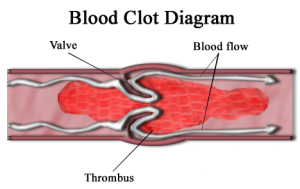If you have a “blood clot”, or are concerned that you may have a blood clot, what should you do?
Firstly, seek medical attention, as this may pose a serious health issue. The diagnosis is made by a test known as a venous duplex ultrasound, also known as a sonogram, ultrasound, or Doppler, of the extremity. This will allow visualization of the veins of the extremity to determine if a clot is present. It would also differentiate between a superficial vein blood clot or a deep vein blood clot, as well as the location of the highest portion of the clot.
Once the diagnosis has been established, a treatment plan will be decided upon. The reason that blood clots of the vein are of concern, is due to the potential of developing a pulmonary embolism. This is when a blood clot from the extremity travels to the blood vessel in the lung, thereby stopping blood flow to that portion of the lung, and causing chest discomfort, and shortness of breath. This can be a fatal situation.
In general, superficial vein blood clots do not cause a pulmonary embolism, but there are exceptions to this rule. At certain points in the extremity the superficial veins connect to the deeper veins, so a clot located at the connection point or close to this connection point are of greater significance.
Deep vein blood clots do pose a significant risk of causing a pulmonary embolism, probably one out of twelve people, and therefore all patients will be treated. The treatment protocol is using anticoagulation drugs, also known as blood thinners. These medications do not destroy the clot, but prevent the clot from becoming larger, and preventing the possibility of a pulmonary embolism. However, only certain patients with a superficial vein blood clot will require treatment with the anticoagulation medications. Those are in situations where the clot is progressing up the extremity, or are located near to the deeper vein connections, or at the deeper vein connecting points. Most patients with a superficial vein thrombosis are treated by conservative management, which may include the use of a compression hose, local warm or cold compresses for symptomatic relief, and homeopathic remedy-Arnica gel which can be rubbed into the affected area. The symptoms and the associated clots usually resolve within a short period of time, probably 2-3 days, but may persist longer in certain cases.
If you have any questions about blot clots, call NYC’s top vascular doctor, Dr. Norman Chideckel today!



Does it effective against arterial thrombosis in the heart?